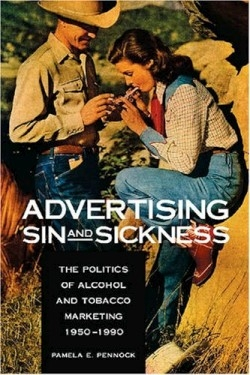
Advertising Sin and Sickness
The Politics of Alcohol and Tobacco Marketing, 1950-1990
Americans have a long and divided history concerning legal recreational drugs. The twin vices of tobacco and alcohol, paired in the public mind, have lead to a deep cultural divide. Along the fault line created by these substances are strange alliances. The religious right, claiming moral authority and the liberal left, using scientific and medical evidence find themselves partnered in a crusade to limit the use, distribution, and marketing of alcohol and tobacco. On the other side are civil libertarians and social conservatives allied by a deep suspicion of government regulation and a regard for principles of free speech. Pamela E. Pennock, assistant professor of history at the University of Michigan, Dearborn, explores the shifting history of this divide and reveals some unexpected and illuminating truths that go beyond a mere chronology of social legislation.
Pennock brilliantly examines these social struggles around the thread of social change inherent in the growth of consumer culture over the past fifty years. The book is concerned with the role of advertising and marketing of alcohol and tobacco, and the legislation arising from attempts to regulate them. What is fascinating, and ultimately more enlightening, is her very convincing probing of major shifts in American culture over this fifty-year period. As Pennock notes in her conclusion, “As the twentieth century advanced, decision making became more dependent on scientific evidence, and in public life religious authority was increasingly displaced by scientific expertise and bureaucratic powers.” Pennock shows how unease about the growth of both “sin” advertising and governmental restrictions on marketing leads to a crisis that is still unresolved in the American mind. The book creates a deeper understanding of how American political structures and powerful industries interact over basic ethical and political ideas, such as the collision between freedom and health, regulation and free speech, profit and public responsibility.
The book is divided into three sections: The fight to ban alcohol advertising (1947-1958), the battle to regulate cigarette marketing in the 1960s, and the new temperance movement of the 1970s and 1980s. This organization works very well in showing a cultural shift from early religious-based moral activism to a scientific, wellness-based movement emerging in the 1960s and the development of a new “secular morality” that emerges in the 1970s and ’80s. Of equal importance is the analysis of these three different periods, showing how earlier movements create trends in later movements and how unrelated trends influence each other.
Reviewed by
Peter Terry
Disclosure: This article is not an endorsement, but a review. The publisher of this book provided free copies of the book to have their book reviewed by a professional reviewer. No fee was paid by the publisher for this review. Foreword Reviews only recommends books that we love. Foreword Magazine, Inc. is disclosing this in accordance with the Federal Trade Commission’s 16 CFR, Part 255.
